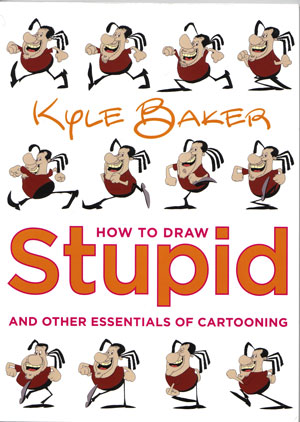 |
|||||
|
|
|
|
|
|
|
| How To Draw Stupid (and Other Essentials of Cartooning) | Jeff Harris, July 14, 2008 |
 Format: Art Instruction and Information
Format: Art Instruction and Information
Author: Kyle Baker Publisher: Watson-Guptill The Skinny: One of the masters of modern cartooning provides wisdom, guidance, and information about how to make your work funny and why so many people fail at it. Think: How to Draw Comics - The Kyle Baker Way
Pros: Great commentary and insight about cartooning and the industry itself, funny as hell drawings, excellent lessons
My Take:
Unless you've been under a rock over the past decade (or just trapped in happy, happy anime manga world), you would know that Kyle Baker's one of the greatest cartoonist of the 21st century, tackling stories of all genres, from humor and drama to sci-fi and superheroics to satire and history and everything inbetween, excelling in them all. Not many people could do that, but Mr. Baker's one of the best at what he does, and he knows it. How to Draw Stupid is an unseemly name on first look, but it's a guide about how to make cartoons work from somebody who knows. Inside, you'll learn some of the essential tricks of the trade from 14 lessons. Some seemed obvious while others will smack you like a mackerel with their immediate impact. The Hand of Death is a lazy trick many cartoons use when animating or drawing people conversing (just as lazy as a head shot). Tell a story through the drawings, showing emotion, characterization, and humor without being so wordy (funny translates in all languages). Don't tell jokes. Don't have a "plan B" (any cartoonist and writer will tell you that they had family members, instructors, friends, and other acquaintences to tell them to do something else in case that cartooning or writing thing doesn't pan out). His criticisms on both the comic and animation industries are dead on, which is why I connected with it so much, from his opinions on why we like modern cartoons (hint: it isn't because of the way they're animated) to the word-heavy nature of the cartoon industry (from scene descriptions to the overuse of dialogue).
If you're looking for design techniques, anatomy lessons, or how to draw your favorite characters, this isn't the book for you. In fact, Mr. Baker says (and proves) that you don't need to know those sorts of things to be a cartoonist. He has an entire chapter on it called "Now, Forget What You've Learned." This book is filled with humor and information any cartoonist could use and be inspired by, and is a great introduction to Kyle Baker, one of the masters of the industry. Then, pick up The Bakers, Plastic Man: On the Lam!, Birth of a Nation, Nat Turner, Truth: Red, White, and Blue, Kyle Baker: Cartoonist, and Why I Hate Saturn . . . for starters.
FINAL JUDGEMENT: 5 out of 5
|
 Who is Kyle Baker?
Who is Kyle Baker?